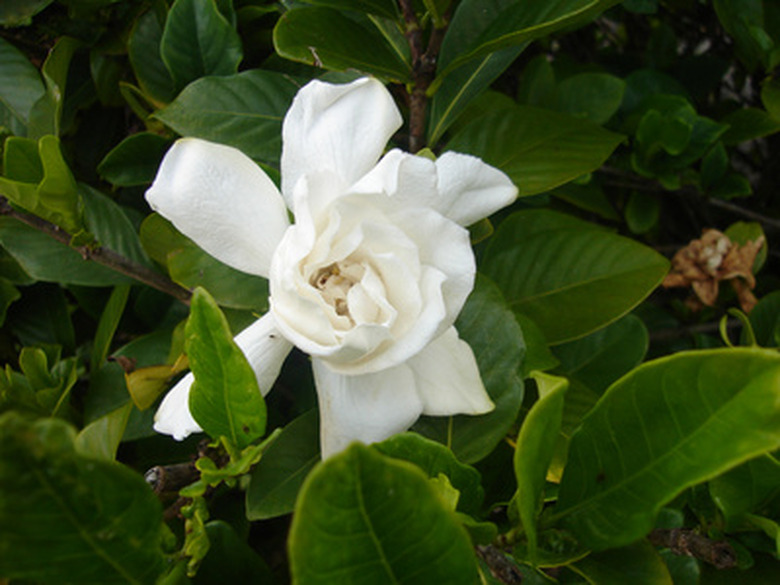Are Gardenias Toxic?
Found both indoors and outdoors, gardenias are known for their white flowers and fragrant smell. Although not all gardenias are poisonous, some varieties of gardenia are toxic to some living creatures.
Humans
According to University of Arkansas, the gardenia is generally considered non-toxic to humans. No known gardenia species has shown signs of toxicity when accidentally consumed by a human. This also applies to small children.
Gardenia radicans floraplena
A common houseplant gardenia variety, gardenia radicans floraplena is non-toxic to any living creature, including cats, dogs or small children, according to the University of Nebraska. Like with any plant, an allergic reaction may occur if the plant is ingested.
- Found both indoors and outdoors, gardenias are known for their white flowers and fragrant smell.
- According to University of Arkansas, the gardenia is generally considered non-toxic to humans.
Gardenia jasminoides
Another species of gardenia, gardenia jasminoides, is non-toxic to humans, but according to the ASPCA, it is often toxic to dogs, cats and horses. Also known as the cape jasmine gardenia, gardenia jasminoides can cause mild vomiting, diarrhea and hives in animals. Although ingestion of the cape jasmine gardenia may cause your pet discomfort, this variety of gardenia is only slightly toxic and does not typically cause a severe reaction, like death.
Gardenias Look Like?
Gardenias are generally hardy in U.S. Department of Agriculture plant hardiness zones 8 through 10, although this can vary by species. Because gardenias aren't very frost-tolerant, many home gardeners grow them in containers and bring them in for the winter or grow them as houseplants. Other gardenias grow to heights of only a foot or so, and spread out instead of up. Most gardenia flowers are white, and some have yellow centers. Flower sizes range from blooms with a 1-inch diameter to flowers that are 6 inches across. They range from dark, glossy green to bright green or a light-yellow green. Many feature foliage with a lighter green underneath. The older leaves on gardenia plants turn yellow, and a few of the oldest usually drop off each year. The common gardenia has a dense, rounded form and averages between 4 and 6 feet in height and width, depending on the cultivar.
- Gardenias are generally hardy in U.S. Department of Agriculture plant hardiness zones 8 through 10, although this can vary by species.
- The common gardenia has a dense, rounded form and averages between 4 and 6 feet in height and width, depending on the cultivar.
Gardenias Look Like?
Gardenias are generally hardy in U.S. Department of Agriculture plant hardiness zones 8 through 10, although this can vary by species. Because gardenias aren't very frost-tolerant, many home gardeners grow them in containers and bring them in for the winter or grow them as houseplants. Other gardenias grow to heights of only a foot or so, and spread out instead of up. Most gardenia flowers are white, and some have yellow centers. Flower sizes range from blooms with a 1-inch diameter to flowers that are 6 inches across. They range from dark, glossy green to bright green or a light-yellow green. Many feature foliage with a lighter green underneath. The older leaves on gardenia plants turn yellow, and a few of the oldest usually drop off each year. The common gardenia has a dense, rounded form and averages between 4 and 6 feet in height and width, depending on the cultivar.
- Gardenias are generally hardy in U.S. Department of Agriculture plant hardiness zones 8 through 10, although this can vary by species.
- The common gardenia has a dense, rounded form and averages between 4 and 6 feet in height and width, depending on the cultivar.
References
- ASPCA: Gardenia
- University of Nebraska: Toxicity of Common Houseplants
- University of Arkansas: Toxic Plants
- Clemson Cooperative Extension: Gardenia
- Plant Lust: Genus Gardenia
- Southern Living: Gardenia Essential Southern Plant
- University of Georgia Cobb County Extension Service: Gardenias
- Clemson Cooperative Extension: Gardenia
- Plant Lust: Genus Gardenia
- Southern Living: Gardenia Essential Southern Plant
- University of Georgia Cobb County Extension Service: Gardenias
